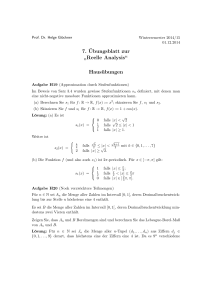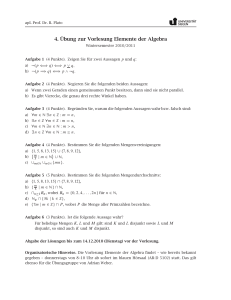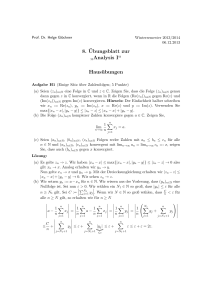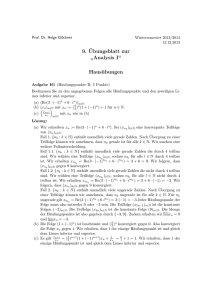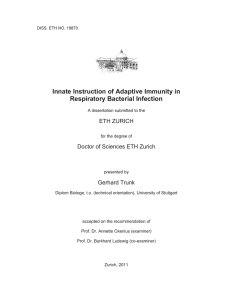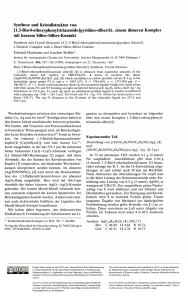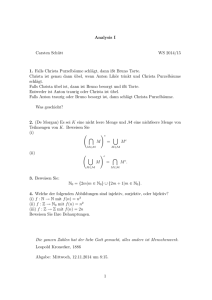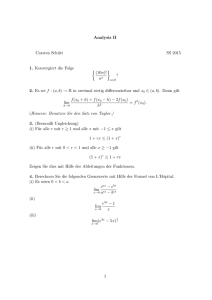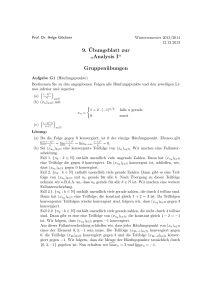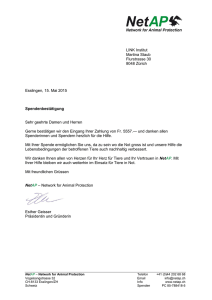Humoral Immune Response to the Intracellular - ETH E
Werbung
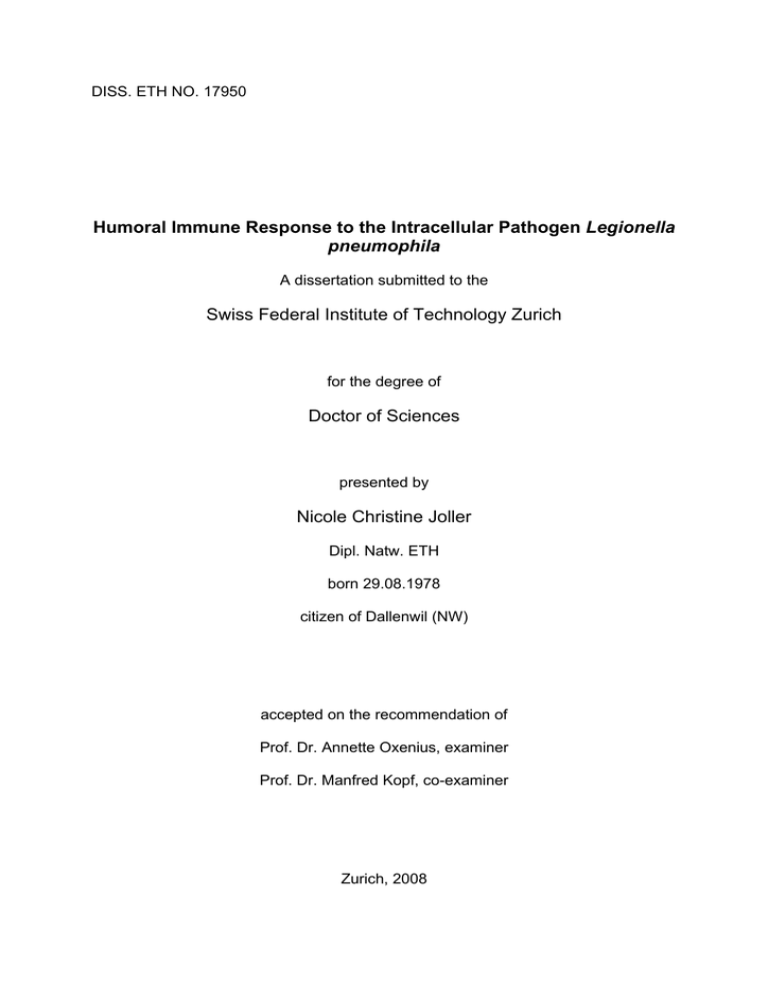
DISS. ETH NO. 17950 Humoral Immune Response to the Intracellular Pathogen Legionella pneumophila A dissertation submitted to the Swiss Federal Institute of Technology Zurich for the degree of Doctor of Sciences presented by Nicole Christine Joller Dipl. Natw. ETH born 29.08.1978 citizen of Dallenwil (NW) accepted on the recommendation of Prof. Dr. Annette Oxenius, examiner Prof. Dr. Manfred Kopf, co-examiner Zurich, 2008 Summary Legionella pneumophila (Lpn) are gram-negative bacteria that, when inhaled, infect and replicate within alveolar macrophages and can, particularly in immunocompromised people, cause a severe pneumonia known as Legionnaires’ disease. By effector mechanisms triggered by the bacterial Dot/Icm type IV secretion system (T4SS), Lpn evade phagolysosomal fusion within macrophages, which allows them to replicate inside the host cell. Although primary infection with Lpn is largely controlled by innate immune mechanisms, in particular by NK cell-derived IFNγ, adaptive immune responses are necessary for protection against secondary challenge. In this thesis we demonstrate that humoral immunity is entirely responsible for this protection. Using A/J mice as a model we have characterized the Lpn-specific B cell response after systemic as well as in intranasal (i.n.) Lpn infection and our results demonstrate that i.v. as well as i.n. infection with Lpn leads to a strong Lpn-specific B cell response, which is accelerated and strongly increased in secondary infection. A functional T4SS is essential for induction of a B cell response in an i.n. infection, as it is essential for the induction of an inflammatory response which in turn seems to be required for the generation of both Lpn-specific IgM and isotype-switched antibody (Ab) responses at mucosal sites such as the lung. We have investigated the role of the Ab response in protection from re-infection with Lpn and shown that the bacterial burden is strongly reduced when mice are infected with Lpn which have been opsonized with polyclonal Abs. This reduction in bacterial titers could be definitively attributed to antibodies as immunized B cell-deficient (JHT) mice were not protected. Furthermore, we demonstrated that the function of Abs in this context was neither to activate complement nor to block the function of the T4SS as Abs were protective in the absence of the central complement component C3 and the T4SS was functional in opsonized bacteria. In vitro and in vivo experiments revealed that the protective effect was mediated by antibody-dependent targeting of the bacteria to lysosomal compartments within the host cell, resulting in an inhibition of intracellular replication. Targeting of Lpn for degradation was dependent on the Fc moiety of the Abs and on the presence of Fc receptors, suggesting that Fc receptor engagement and III subsequent signaling events impede the strategies by which Lpn evades phagolysosomal fusion. We further showed that Ab-mediated protection is effective across Lpn serogroups, indicating that Abs specific for conserved protein Ags are sufficient to mediate protection against Lpn. We could identify 30 of these protein Ags by using two independent methods, namely the screening of a phage library constructed from the Lpn genome and 2-dimensional gel electrophoresis followed by Western blot analysis and mass spectronomy-based protein identification. These Lpn B cell Ags are predominantly located in or associated with the bacterial membrane, where they are accessible for Abs and therefore likely to be relevant for Ab-mediated protection against Lpn. IV Zusammenfassung Der bakterielle, Gram-negative Krankheitserreger Legionella pneumophila (Lpn) kann, besonders bei Personen mit einem geschwächten Immunsystem, nach Inhalation alveoläre Makrophagen infizieren und dadurch eine schwere Lungenentzündung (Legionärskrankheit) auslösen. Mit Hilfe des Dot/Icm Typ IV Sekretionssytems (T4SS) entziehen sich die Bakterien dem lysosomalen Abbau durch die Wirtszelle und können sich so in den Alveolarmakrophagen vermehren. Die primäre Lpn-Infektion wird durch das angeborene Immunsystem, insbesondere durch die Sekretion von IFN-γ durch NK Zellen kontrolliert. Für einen Schutz vor sekundären Infektionen ist hingegen eine adaptive Immunantwort nötig. In dieser Arbeit zeigen wir, dass dieser Schutz gänzlich durch die humorale Immunantwort vermittelt wird. Mit Hilfe des A/J-Mausmodells haben wir die Lpn-spezifische B Zellantwort nach systemischer und intranasaler (i.n.) Infektion charakterisiert und unsere Ergebnisse zeigen, dass beide Infektionen eine starke B Zellantwort auslösen, welche in Sekundärantworten noch weiter verstärkt ist. Des Weiteren stellte sich heraus, dass die Anwesenheit eines funktionellen T4SS und die davon abhängige Entzündungsreaktion für die Induktion einer mukosalen IgM Antwort, sowie für die Entstehung von Antikörpern (Ak) des IgG und IgA Isotypes, essentiell ist. In einem weiteren Schritt haben wir die Rolle der Ak beim Schutz gegen sekundäre Infektionen analysiert und konnten zeigen, dass die Bakterienlast durch Opsonisierung von Lpn mit polyklonalen Ak stark reduziert werden kann. Diese Reduktion konnte eindeutig der Funktion von Ak zugeordnet werden, da immunisierte B Zell-defiziente Mäuse (JHT) keinen Schutz aufwiesen. Wir konnten ausserdem zeigen, dass Ak diese Schutzfunktion nicht durch Aktivierung des Komplememtsystems oder Blockierung des T4SS ausüben, denn auch in Abwesenheit von C3, einer zentralen Einheit des Komplementsystems, wirken sie schützend. Hinzu kommt, dass das T4SS auch in opsonisierten Lpn funktionell war. In vitro und in vivo Experimente zeigten, dass die schützende Wirkung der Ak auf deren Fähigkeit zurückzuführen ist, die Bakterien in das Lysosom der Wirtszelle zu zwingen und damit deren Replikation zu verhindern. Für diesen Prozess sind der Fc- V Teil des Ak sowie Fc Rezeptoren absolut notwendig. Dies deutet darauf hin, dass die Bindung der Ak an Fc Rezeptoren und die damit verbundene Signaltransduktion den Mechanismen, die Lpn anwenden um dem lysosomalen Abbau durch die Wirtszelle zu entkommen, entgegenwirken. Ausserdem konnten wir zeigen, dass Ak, mit grösster Wahrscheinlichkeit diejenigen mit Spezifität für konservierte Proteine, auch über verschiedene Serogruppen hinweg Schutz vor der Lpn Infektion vermitteln können. Dreissig dieser Proteinantigene konnten mit Hilfe zweier unabhängiger Methoden (Screen einer Phagenbibliothek and zweidimensionale Gelelektrophorese mit anschliessender Westernblot Analyse und massenspektrometrischer Proteinidentifikation) identifiziert werden. Diese B Zellantigene befinden sich hauptsächlich in der Bakterienmembran oder sind zumindest damit assoziiert. Dies gewährleistet die Zugänglichkeit dieser Antigene für Ak und lässt vermuten, dass diese auch im Schutz vor Lpn Infektionen eine Rolle spielen. VI
